Arizona Vegetable & Fruit Gardening
For The Arizona Desert Environment.
Pictures, Photos, Images
Descriptions
Information, & Reviews.
 |
| Tomato, Solanum lycopersicum. "San Marzano" Variety. Photo Courtesy Of Wikipedia, the free encyclopedia. |
|---|
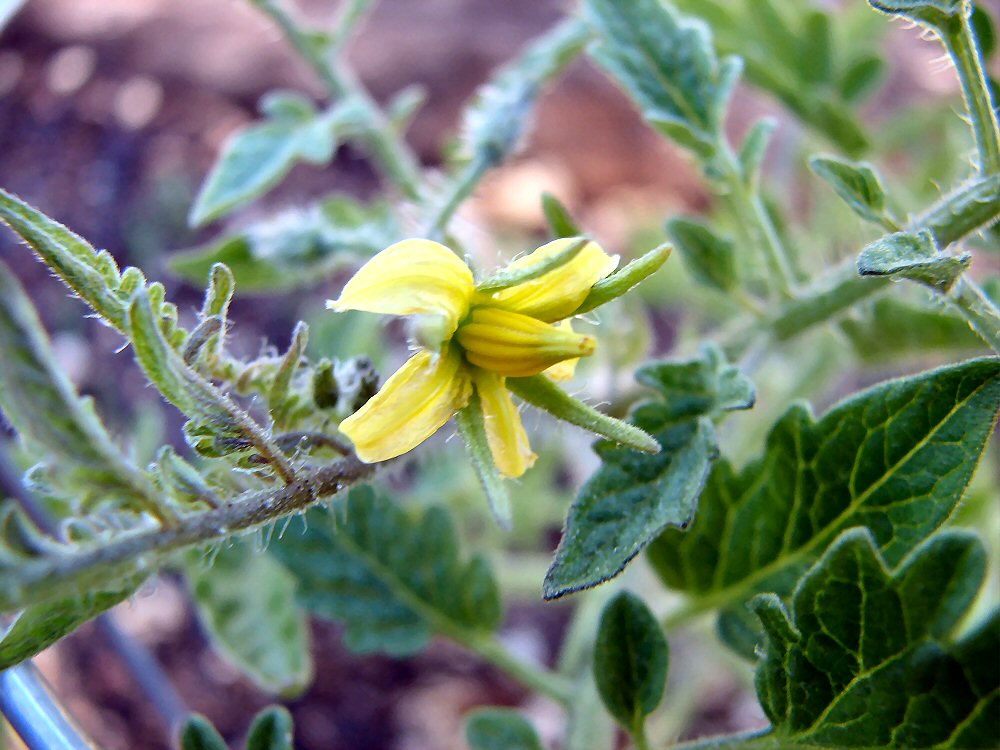 |
| Tomato, Solanum lycopersicum. "San Marzano" Variety. Photo Taken June 25, 2011 In Yarnell, Arizona. |
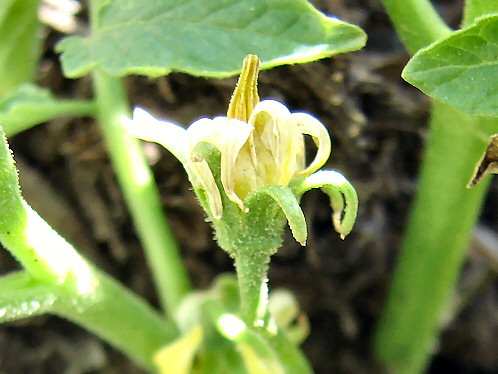 | 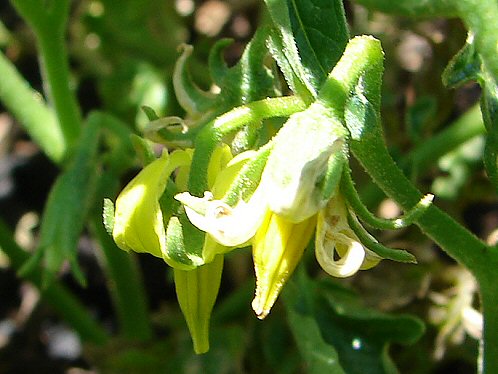 |
| Flower. Tomato, Solanum lycopersicum. "San Marzano" Variety. | Tomato, Solanum lycopersicum. "San Marzano" Variety. |
|---|---|
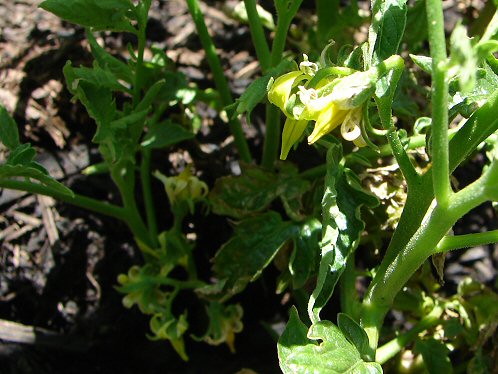 | 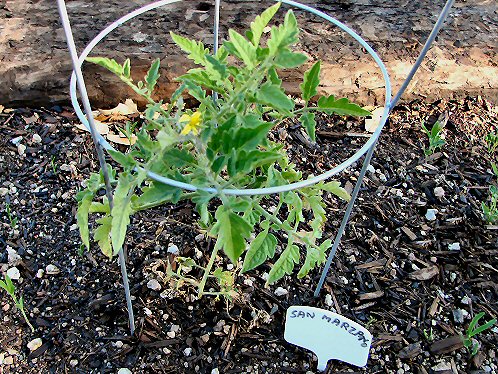 |
| Flower. Tomato, Solanum lycopersicum. "San Marzano" Variety. | Tomato, Solanum lycopersicum. "San Marzano" Variety. |
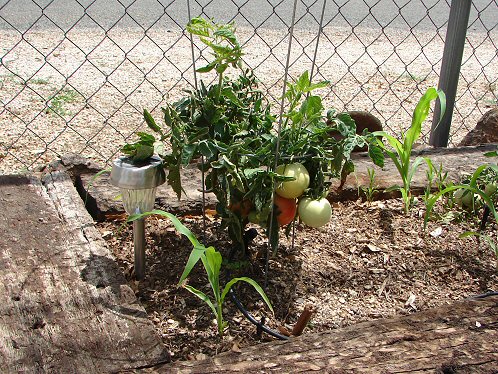 | 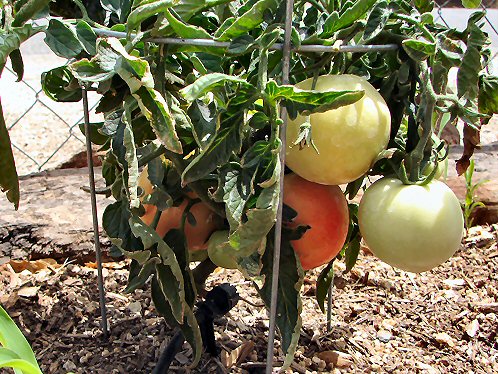 |
| Plant. Tomato, Solanum lycopersicum. "Solar Fire VFFF Hybrid" Variety. | Plant Tomato, Solanum lycopersicum. "Solar Fire VFFF Hybrid" Variety. |
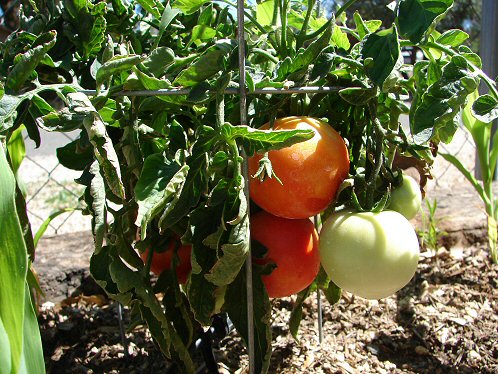 |  |
| Plant. Tomato, Solanum lycopersicum. "Solar Fire VFFF Hybrid" Variety. One Week Later, Notice The Change In Color, From Ripening. | Plant Tomato, Solanum lycopersicum. "Roma V F" Variety. |
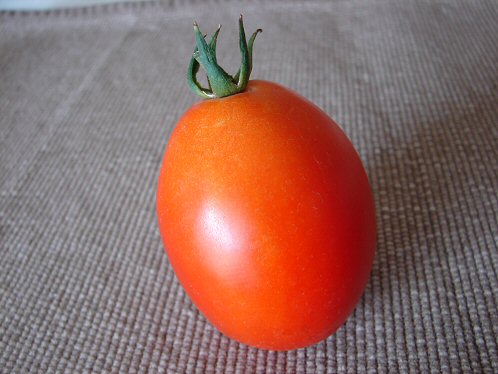 | 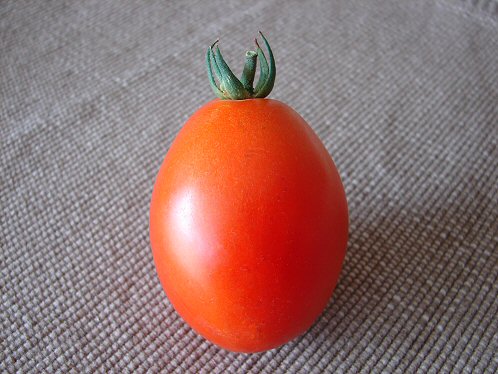 |
| Fruit. Tomato, Solanum lycopersicum. "Roma V F" Variety. | Fruit. Tomato, Solanum lycopersicum. "Roma V F" Variety. |
Tomato
Solanum lycopersicon is the botanical name for the Tomato plant. Tomato fruit are popular all over the world and there are more varieties of tomatoes sold than of any other vegetable. NOTE: All of the photos on this page are of Solanum Lycopersicon esculentum, commonly called: "San Marzano", a sought-after heirloom from the Campania region of southern Italy. You can buy it in expensive imported cans or, even better, grow your own at home. Vines start bearing later in the summer but then come on fast and furiously, producing heavy, 3�-inch-long tapered fruits in clusters of five or six. "San Marzano" is low in sugar and acid, which gives it superior flavor when cooked. The vigorous plants are extremely prolific and produce until the first hard frost. As the most famous plum tomato for making sauce, the San Marzano is preferred by Gourmet Chefs and Cooks all over the world. In Italy and elsewhere in Europe, they are a household name. In organic & specialty food stores in the United States, imported and certified SM's sell for eyebrow raising prices. Foodies and connoisseur's, to put it politely but accurately, are FANATICAL about certified San Marzano tomatoes and talk about them with elitist sounding hyperbole. Gardeners too prefer them for homemade sauces and carefully and lovingly raise their San Marzano plants all season long. Today, the San Marzano is preferred by Gourmet Chefs and Cooks all over the world. In Italy and elsewhere in Europe, they are a household name. Simply put, it is the most famous plum tomato in the world for making sauce! Several years ago the "San Marzano" had become lost, and a new rebreeding program was again started, and on July 10, 1996 the San Marzano tomato made the new beginning of it's comeback. On that date, the San Marzano tomato in the Agro Sarnese Nocerino region of Campania was granted Protected Designation of Origin (PDO) status by the European Union. The two cultivators deemed of most value for the future crop strains were Cirio Selection 3, and the SMEC 20, which was renamed the San Marzano 2. Only the cans of San Marzano tomatoes with the EU's DOP seal are guaranteed by the European Union to be authentic and genuine San Marzano tomatoes from the region in which it is the most native. DOP status is granted to many different food items. (In Italian, it is 'Denominazione d'Origine Protetta, and abbreviated, DOP. All of the imported cans of San Marzano tomatoes say DOP). Cans of San Marzano tomatoes with the EU's DOP seal can be found in speciality stores and even Costco, but they have an expensive price. We have tried some fresh San Marzano's when visiting Peru in March and April of 2011 and we had to try growing them in Yarnell, Arizona for ourselves!
OK, Back to the garden tomato! The garden varieties of Tomato come from two wild types; L. esculentum and L. pimpinellifolium which are originally from western South America. The question is asked, "where did the tomato come from?" Pinpointing where tomatoes began is not always easy. Vavilov, a renowned Russian scientist, conceived the idea that if one wants to locate the very center of origin for any crop species, look for the area which still has the highest diversity of that crop. This is grounded on the idea that only a portion of the wild plant gene pool will be incorporated into a domesticated plant line, such that the cultivated crop will represent only a portion of the genetic variety found in the wild ancestors which presumably are still inhabiting the area, in more or less the same form, to this day. By Vavilov's logic, one would should closely at the western coast of South America, in present day Peru, where there are eight species of the tomato genus still growing wild in the Andes Mountains. This current range of wild tomato relatives extends from the northern tip of Chile on the south, to Ecuador on the north, reaching inland from the Pacific Ocean for about 100-200 miles, also including the Galapogos Islands. Thus the oldest species of tomatoes, Lycopersicon esculentum, is specifically native to the Andes region of Chile, Colombia, Bolivia, and Peru. It is believed that they were first domesticated in Mexico. Lycopersicon is Latin for "wolf peach," another common name for the tomato that hints at its perceived poisonous nature. While the tomato was introduced into European gardens in the early part of the sixteenth century, it wasn't accepted as being edible; this was because it belongs to the Nightshade family (Solanaceae), and resembles many plants that were known to be poisonous; however, it was grown as an interesting ornamental plant. Tomatoes are known to have been grown in 1781 by Thomas Jefferson in Virginia, but they weren't considered in America, as an edible food, until after 1834 and it was several years later that they became popular. North Americans believed tomatoes were poisonous until 1820, when Colonel Robert Gibbon Johnson disproved that myth during a public demonstration on the courthouse steps in Salem, NJ. In France, after the poison myth was dispelled, the people came to believe the tomato was an aphrodisiac and called it "pomme d'amour," or "love apple." An interesting U.S. Supreme Court decision was made in 1883 concerning the tomato. Botanically, the tomato is a fruit, but in 1883 U.S. Supreme Court decided the tomato was legally a vegetable. Of course, tax money had to be involved. This court case was brought about because New Jersey importer John Nix refused to pay an import tariff on his tomatoes, arguing that technically they were fruits. While the Supreme Court justices agreed that botanically tomatoes were fruits, it was decided that commonly they were vegetables and therefore subject to the same tariff as other vegetables. They may be eaten either cooked or raw and they are a good source of vitamins. The Tomato has also been called the Love Apple, Pomo D'Oro and Garden Apple. Tomatoes come in a wide range of shapes, sizes and colors. Some may be globe, round, flattened, oval, heart, or elongated and square shaped. Their colors may be red, orange, pink, golden, yellow, striped, or white. The average weight for the garden tomato used for slicing is 4 to 6 oz., but some varieties weigh up to 2 pounds. High quality Tomatoes have a good ratio of cell wall to pulp and a short, soft core. Even though there is a lot said about the flavor and acidity, there is actually little variation among varieties in the pH of the ripe fruit. More important is the amount of sugar. There are about 7.33 g of sugar per 100 g of a tomato. Remember there is about 4 grams of sugar is the typical sugar packet. Depending on the size and health of a plant and the temperatures during pollination, a Tomato plant can produce 10 to 50 pounds of good fruit. Some types can produce fruit under cooler or warmer weather conditions, or often both. Some older varieties will only produce fruit under a limited range of temperatures. VARIETIES: There are around 7,500 tomato varieties grown for various purposes. Therefore, we will not be able to mention them all here in this article. Heirloom tomatoes are becoming increasingly popular, particularly among home gardeners and organic producers, since they tend to produce more interesting and flavorful crops at the cost of disease resistance and productivity. Hybrid plants remain common, since they tend to be heavier producers, and sometimes combine unusual characteristics of heirloom tomatoes with the ruggedness of conventional commercial tomatoes. Tomato varieties are roughly divided into several categories, based mostly on shape and size. There is also a considerable gap between commercial and home-gardener cultivars; home cultivars are often bred for flavor to the exclusion of all other qualities, while commercial cultivars are bred for such factors as consistent size and shape, disease and pest resistance, suitability for mechanized picking and shipping, and ability to be picked before fully ripening. Tomato plants fall into 3 groups. "Indeterminate" vines grow constantly throughout the season; "large determinate" vines grow to a good size, but increase little more after that; "determinate" vines stay small to medium size no matter how much you nourish and water them. Compact or dwarf vines are even smaller and some are just right for pots. Vine growth depends on the variety. They may be erect, sprawling or have drooping branches, great for hanging baskets. Most kinds have the usual Tomato foliage, but some have thick, dark leaves resembling those of the Potato. Some midget varieties have miniature leaves. Two other types of tomato deserve special mention. Cherry Tomato (L. lycopersicum variety cerasiforme) - "Cherry" refers to the shape and size of the fruit. They may be colored red or yellow and their size ranges from one-half to five-eighths inch in diameter to the size of a ping-pong ball. The clusters or "hands" of Cherry Tomatoes can be very large and produce up to 100 Tomatoes each. A Cherry Tomato plant can easily match or top slicing Tomato vines of equal size in fruit production. Most types have high-climbing indeterminate vines and the fruits of some have relatively tough skin. Vines can be staked, grown in cages, or pruned to 1 or 2 leader stems and run up strings or shoots. Large Red is the old standard. The small-fruited Sweet 100 Hybrid is much sweeter and has a high content of vitamin C along with fairly tender skin. Cherry Grande VF is another variety to consider. Some midget varieties of standard Tomatoes have fruit the same size as Cherry Tomatoes, but generally produce less fruits per hand. Pear Tomato (L. lycopersicum variety pyriforme) - These vines are similar to the Cherry Tomato (tall and indeterminate), but not as productive. Pear tomatoes have small fruits, no larger than 2 inches by 1 inch and nipples on the stem ends. "Plum" and "Peach" Tomatoes are similar but don�t have nipples. All three varieties come in red or yellow and have tender skins and juicy interiors. A lot of chefs consider Pear, Plum and Peach Tomatoes to be the greatest for eating. Some of the paste Tomatoes, however, whether plum- or pear-shaped, are solid and dry. Common varieties are: Pear, Plum, Peach Tomato - Red Plum, Red Pear, Yellow Plum, Yellow Pear, Roma VF Hybrid, Early Baby Boy. There are so many varieties of Tomatoes that you need to check the many catalogues and seed and plant displays for tomatoes that will meet your needs. There is no single variety or hybrid that will combine all the best features. Find out which varieties are suitable for home gardens and which tomato diseases are prevalent in your area so you can choose resistant varieties. There are many different things to consider when selecting your plants. GENERAL REQUIREMENTS FOR ALL TOMATOES: At least two varieties will be needed in your garden. You should choose one early variety and one midseason or late. If space is limited, choose determinate or midget kinds. Plant extremely early varieties in short-season gardens; avoid late varieties where seasons are short or cool. Varieties are classified and tested according to the number of days from transplanting to the first ripe fruit. In your own personal garden, the number of days may vary by a few days from the catalogue listings. Summer plantings ordinarily mature faster than spring plantings. Extra-early varieties mature in 58 to 63 days from transplanting; early types need 64 to 70 days; midseason kinds require 71 to 79 days; and late varieties need 80 days or more. The coverage of the foliage can range from dense to sparse. Thick foliage is better for southern and western gardens because it protects against sunburn, but in northern gardens it can impede ripening. Extra-early dwarf varieties usually have a thin canopy; they tend to sunburn in the South and Southwest. Resistance or tolerance of certain diseases is usually indicated by an initial in the variety name. Examples are verticillium (V), fusarium (F), nematodes (N), tobacco mosaic virus (T) and alternaria (A). Look for varieties that also resist stem canker, leaf mold, gray leafspot and blossom-end rot. You may also want to think about the way(s) that you plan on using your Tomatoes. If you want a succession of fruits, you might choose a variety with an extended maturity. Or, you might want many ripe Tomatoes at once, if you are planning to can them. There are many different things to consider when selecting your plants.
Here is a new variety for Arizona Gardens: OK, this variety was not invented in Arizona, but in Florida. We have tried it and it is great! Especially for our hot, dry, Arizona climate! Solar Fire VFFF Hybrid:The Rodeo Tomato! Solar Fire is a heat-tolerant variety developed by researchers at the University of Florida's Institute of Food and Agricultural Sciences. Solar Fire has medium to large-sized fruit, just above 6 ounces, with an attractive red color and gloss. Each vine bears a lot of fruit, so crop yields are good. It is a firm tomato. It's best when eaten fresh in salads or sandwiches, rather than cooked or canned. Solar Fire is resistant to races 1, 2 and 3 of Fusarium wilt, as well as Verticillium wilt race 1 and gray leafspot. It has moderate resistance to fruit soft rot, a bacterium that attacks damp tomatoes after the fruit has been harvested. Solar Fire has improved crack tolerance. Its large firm fruit ripen well. Medium vines do not require pruning.
Here are a few of the more common varieties available: Early: Siberia, Early Girl V Hybrid, Champion VFNT Hybrid, Sprint A. Midseason: Better Boy VFN Hybrid, Burpee's Big Girl VF Hybrid, Freedom VFF, Parks Whopper VFNT, Celebrity VFNT Hybrid (AAS). Late: Beefmaster VFN Hybrid, Golden Boy, Royal Ace VF. The Tomato is grown as a warm-weather annual, although it is actually a tender perennial. It is grown in greenhouses where summers are too cool for pollination and fruit to set in gardens. Tomato plants are vines, initially decumbent, typically growing six feet or more above the ground if supported, although erect bush varieties have been bred, generally three feet tall or shorter. Indeterminate types are "tender" perennials, dying annually in temperate climates (they are originally native to tropical highlands), although they can live up to three years in a greenhouse in some cases. Determinate types are annual in all climates. Tomato plants are dicots, and grow as a series of branching stems, with a terminal bud at the tip that does the actual growing. When that tip eventually stops growing, whether because of pruning or flowering, lateral buds take over and grow into other, fully functional, vines. Tomato vines are typically pubescent, meaning covered with fine short hairs. These hairs facilitate the vining process, turning into roots wherever the plant is in contact with the ground and moisture, especially if there is some issue with the vine's contact to its original root. After flowering, tomatoes require 50-60 days to reach fruit maturity. Although the full size of the fleshy fruit, called a berry, is attained in half that time, the later stage of maturity is marked by external color change with coinciding internal chemical changes. As the fruit changes from green to red, the acidity decreases, and both the sweetness and the vitamin A and C contents increase. The original green color is due to chlorophyll, the main photosynthetic pigment. As the chlorophyll breaks down, additional carotenoids are synthesized-lycopene, a red accessory pigment, and lesser amounts of �-carotene, an orange accessory pigment. This change in internal and external morphology is due mainly to the presence of ethylene, a gaseous hormone that wasn't discovered until 1901. GENERAL REQUIREMENTS FOR ALL TOMATOES: All tomatoes, are sensitive to frost and cold soil temperatures. Plant your main crop when the soil is warm and all danger of frost is past. Rotate the location of your bean crops from year to year to discourage disease. WHERE & HOW TO PLANT: Select a site with full sun and well-drained soil to prevent "blossom-end rot". It should be tilled deeply before they are planted. It would be profitable if the soil was enriched with compost, leaf mold, peat moss or commercial humus. Manure should be used, if at all, with caution. The soil pH should be 6.0 to 7.0 and this can be maintained with dolomitic limestone, which ensures adequate calcium and magnesium. Soil that has a pH of 7.0 or higher may benefit from applications of agricultural sulfur. The ground should always be kept free of weeds by mulching or raking the ground about an inch deep after the plants are well established. Set plants out after danger from frost has passed and plant them a bit deeper than what they were growing in their containers. If your plants are a bit spindly, plant them on their sides and cover with dirt up to their first leaves. Roots will grow along the buried stem and produce sturdier plants. Space the plants about 2� feet apart, in rows 2� to 3� feet apart. Prepare the garden bed by using a garden fork or tiller to loosen the soil to a depth of 12 to 15 inches, then mix in a 2- to 4-inch layer of compost. Care. Keep planting beds weed free; cultivate shallowly to avoid disturbing roots. If you are expecting cold weather, cover your Tomatoes with bottomless, 1-gallon plastic jugs for 2 or 3 weeks. When the young plants are exposed to cold, but protected from frost, they are "vernalized". This treatment can increase the quality and quantity of fruit production, especially early in the season. Smaller, cold treated seedlings will catch up quickly and do better than large, forced plants. *NOTE: If plants are started very early indoors and grown there until they start to blossom and fruit, transplanting may shock them and cause a setback in growth, if they recover at all. All of your Tomatoes, except for some dwarf varieties, should be provided with some type of support. You can make cages of large-mesh wire fencing rolled into cylinders, 2 to 3 feet wide and 5 to 6 feet high. The mesh should be large enough for you to to reach your hand through when it comes time to harvest. You can use wooden stakes to hold up the cages. Some gardeners prune their vines to 2 leader stems and run them up sturdy strings or twine. The side shoots or suckers can then be pruned off. Since these plants will become tall and slender, they are much easier to spray and keep free of tomato diseases and pests. Never let your Tomato plants dry out. The fruits will crack if they are subjected to a dry period and then provided with moisture. However, if you keep the soil is saturated with water during the days leading up to the tomato harvest, flavorless, watery fruit could be your result. Tomato plants are moderate feeders, especially the small, determinate varities. Don't use fertilizer that contains too much nitrogen. An over abundance of nitrogen will cause lush vegetation and delay the plants maturity and hinder fruit production. Tomato diseases may be troublesome even in resistant hybrids. Luckily, there are relatively safe insecticides with negligible residues for the control of soft-bodied tomato insects. We generally use Sevin. Companion plants: Carrots, Chives, Onions, Garlic, Borage, Asparagus, Marigolds, Nasturtiums, Basil, Spinach, Lettuce, & Arugula. Do not plant tomatos with Brassicas, Corn, Fennel, Kohlrabi, or Potatoes. Container growing: Tomatoes can be grown in containers. Follow the above advice about the soil and watering. Greenhouse cultivation: Tomatoes may be had during the winter by growing them in a greenhouse that maintains a 55- to 60-degree temperature during the night, with a few degree rise during the day. They must be able to have full exposure to sunlight. They may be grown in large containers or in beds. If they're grown in beds, they need 12 to 15 inches between each other; if they are potted, they need containers that are 9 to 10 inches in diameter. They will need some kind of support. Each plant should only be allowed one stem by pinching off all side shoots when they are small. It is beneficial to choose a variety especially suited for greenhouse culture. The general care of the plants is the same as if they were grown outside. In order to endure the production of fruit, it is necessary to pollinate the flowers or treat them with a special hormone spray, which can be bought for that purpose. Pollination can be accomplished by gently shaking the plants during the middle of each warm, dry day at a time when the air in the greenhouse is fairly dry. Another way is to take a soft camel's-hair brush and gently stroke it across every open flower each warm, bright day.
Propogation From Seed: If you are going to plant tomato seeds, use a "seed-starter mix" (usually contains equal amounts of sifted loam, sand and leaf mold to make a good mixture) rather than regular potting soil. Start the seeds indoors, about weeks before the frost-free date at a 75- to 80-degree temperature. Water the soil thoroughly with a fine spray and plant the seeds; they should be covered with about �-inch of soil. Once the first true leaves appear, they should be placed in at spot where the night temperature reaches between 50 to 55 degrees. Your daytime temperature should range from room temperature to 80 degrees. Remember cool nights prevent the plants from becoming lanky. Don�t over water your plants while they are young and maintain strong source of light either from either the sun or from fluorescent lights placed about 2 inches above the plants. After 3 weeks of growth, you can set your plants where the night temperature reaches between 60 to 65 degrees. When the outside temperature is safe, they may be placed into the garden and taken care of as described in the regular gardening section.
FOR SWEET TOMATOES; HOW TO PLANT: This may sound strange, but many tomato gardeners say that if you add sugar to your garden you will grow sweeter tomatoes. Here is how it is done....
1. Verify that your nighttime temperature average is at least 55 degrees F. 2. Check the pH of your garden's soil. Make sure it's between 6.2 and 6.8. 3. Select a variety of tomato to grow. Take your geographic region and climate into account. 4. Purchase tomato plants from a lawn and gardening center or local greenhouse. Verify that the tomato plant is healthy, not flowering, and lacks visible yellowing or speckled leaves. 5. Allow the plant to adjust to the outdoors. Gradually introduce the plant to increasing amounts of sunlight over a 7-day period. 6. Dig a hole the size of a volleyball in your garden. When picking places to plant tomatoes, choose sunny areas where you haven't grown nightshade plants for at least 2 years. If you have more than one tomato plant, space the plants at least 2 feet apart from each other. 7. Spoon 1 tsp. of sugar into the hole. 8. Place the tomato plant on top of the sugar. Verify that the roots cover the sugar. 9. Add some compost or manure to the soil while packing the plant down. Keep the soil, compost and manure below the lowest leaves on the stem. Ensure that the tomato plant is packed firmly into the ground. 10. Water your tomatoes regularly and uniformly. Keeping your tomatoes hydrated keeps them healthy and growing at a good pace. 11.Harvest tomatoes only when they are completely ripe. Test your tomatoes' ripeness by gently squeezing them to verify their softness. 12. Enjoy your sweet tomatoes within 3 days of picking them. PESTS: Cultural practices are helpful in avoiding many insect infestations. Tomatoes should be planted in well-prepared, fertile beds, mulched and properly watered to promote vigorous growth. Stressed plants tend to attract more insect pests than healthy plants. In a home garden, handpicking and destroying many pests is an effective control measure. In addition, beneficial insects are very helpful in controlling insects such as aphids, leafminers and hornworms. To avoid killing these beneficials, use insecticides only when necessary. Insecticides such as permethrin, cyfluthrin or esfenvalerate are effective in controlling stink bugs, leaf-footed bugs, aphids, fruitworms and hornworms. Do not use permethrin on tomato varieties with fruit less than one inch in diameter. Carbaryl will control cutworms, fruitworms and hornworms. Bacillus thuringiensis (B.t.) products are natural insecticides that contains spores of this bacterium and are used to only control caterpillars (the smaller the better) when they feed on leaves with the spores. B.t. products such as Dipel (dust) and Thuricide (liquid concentrate) are effective in the control of hornworms and tomato fruitworms. Sprays give better coverage and stay on the plants longer than dusts. Spinosad is a natural product for the control of caterpillars and thrips. Pyrethrin is a natural product for the control of aphids and caterpillars. Neem oil extract and insecticidal soap are less toxic options for control of aphids and whiteflies. Adequate coverage of upper and lower leaf surfaces with these insecticides is important for good pest control.
Tomatoes can be attacked by the following insect pests: According to Clemson University Cooperative Extension: Tomato Fruitworm (Helicoverpa zea), Potato Aphids (Macrosiphum euphorbiae), Brown Stink Bugs (Euschistus servus), Green Stink Bugs (Acrosternum hilare), Leaffooted Bugs (Leptoglossus phyllopus), Tobacco Hornworm (Manduca sexta), Silverleaf whitefly (Bemisia argentifolii), & perhaps Tomato Hornworm (Manduca quinquemaculata). These pests can be controlled with bifenthrin, cyhalothrin, or malathion. We personally use bifenthrin and find it to be the best in both its ability to control pests and its cost. Here is a link to Clemson University Cooperative Extension for a more detailed description of tomato insect pests with pictures of them and what to do for them. DISEASES: Bacterial Wilt or Southern Bacterial Blight (Ralstonia solanacearum) (formerly Pseudomonas solanacearum), Early Blight (Alternaria solani), Late blight (Phytophthora infestans), Septoria Leaf Spot (Septoria lycopersici), Leaf Mold (Cladosporium fulvum), Bacterial Spot (Xanthomonas vesicatoria), Buckeye Rot (Phytophthora parasitica), Fusarium Wilt (Fusarium oxysporum), Southern Blight (Sclerotium rolfsii), Seedling Disease or Damping-Off (fungi Pythium and Rhizoctonia), Viruses, Here is a link to Clemson University Cooperative Extension for a more detailed description of tomato diseases and what to do for them. HARVEST: Here is that moment you have been waiting for! Tomato fruit that is fully ripened on the vine has a much fuller flavor than fruits that are picked early and then allowed to ripen. Most cherry tomatoes, have a tendency to crack if they stay on the plant, so they should be picked at the peak of their redness, or even a little bit before. When daytime temperatures in the fall drop consistently below 60 degrees Fahrenheit, tomato fruit will no longer ripen on the vine, so it is time to harvest all mature green fruits indoors, either on or off the vine. STORING: First of all, select tomatoes that are round, full and feel heavy for their size, with no bruises or blemishes. The skin should be taut and not shriveled. Store fresh ripe tomatoes in a cool, dark place, stem-side down, and use within a few days. If not, they will spoil! Refrigeration is the enemy of the tomato as it nullifies flavor and turns the flesh mealy within 2 - 3 days. A compound called Z-3 hexenel, which accounts for the tomato's scent and taste is the cause. You can salvage some of your tomatoes that haven't yet ripened by wrapping them in newspaper and storing them in a cool area between 55 and 70 degrees F for two to four weeks. Store them no more than two deep and check them often to use the ones that have begun to ripen. Don't expect them to be as good as ones you've ripened on the vine, but they will probably still be better than store-bought. You could can your tomatoes but, unopened canned tomatoes should be used within six months. Once opened, store canned tomatoes in a covered glass container in the refrigerator up to one week. Leftover tomato paste and sauce can be frozen for up to two months. Freeze one tablespoon of tomato paste in each section of an ice tray, pop out when frozen, and seal in an airtight baggie for quick, pre-measured additions to soups and sauces. They need not be thawed prior to adding to your recipes in most cases. If you have freezer space, you should consider freezing your excess tomatoes rather than home canning. It's much easier, and the flavor and texture are better, although they will no longer be good for fresh usage. To freeze, rinse and dry them thoroughly. Then place them in ziptop plastic bags and suck out the air with a straw. No peeling or blanching is necessary. Once thawed, the skins will easily slip off. They will be perfect for cooked dishes and will retain more of that fresh flavor, rather than the cooked, canned flavor.
HINTS FOR GROWING BETTER TOMATOES: 1. When planting tomatoes, work the soil well to encourage plants to send down a good root system. 2. For best flavor, allow tomatoes to develop on the plant to their full color before picking. 3. On determinate plants, let suckers grow. On indeterminates, decide how many "main" stems you want, and pinch off all suckers after you've got that number on each plant. For larger (but fewer) fruit, limit the number of stems. 4. Prevent blossom end rot by keeping the soil evenly moist and by adding a tablespoon of Epsom salts to the hole at planting time. Calcium will also help prevent this problem. 5. In cold climates use row covers or Wall O' Waters to protect tomato transplants from frost and improve yield. 6. Tomatoes love plenty of sun. Plant in the sunniest location and they will produce faster and be more prolific. 7. To develop strong stems, place a fan over tomato seedlings for up to 10 minutes a day, at least twice a day. This will also improve air circulation and keep many fungal diseases at bay. 8. Plant tomatoes on their side (horizontally in a trench) or up to their first set of leaves in a deep hole. Roots will develop all along the underground stem to help plants suck up moisture. 9. Tomato varieties, such as Oregon Spring, Early Girl, and Stupice, are bred to develop fruit early and are perennial favorites. 10. Seedlings require plenty of light. Use a grow light (up to 18 hours per day) or keep them in an area that receives plenty of direct sunlight. 11. If seedlings become tall and weak (leggy) they need more light. To remedy, lower grow lights to two inches above plants and cool grow room temperature to around 65 degrees F. 12. When purchasing tomato plants for your garden, look for healthy green plants with thick stems and no tomatoes or flowers. 13. To reduce insect and disease problems, rotate tomato plants so that they are grown only once in the same spot every three years. 14. If a heavy frost is expected, harvest all tomatoes, including green ones, which will eventually ripen while kept in storage. 15. Like most garden plants, tomatoes prefer rich, fast-draining soil that has been amended with plenty of organic compost or well-aged animal manure. 16. Keep out of the garden when the soil is wet to avoid compacting the soil. 17. As plants approach 3-feet tall, remove many of the leaves from the bottom 1-foot of the stem. These leaves receive very little sunlight and are often the first to develop fungal problems. 18. A layer of organic mulch (compost, leaves, grass clippings) will help deter weeds and keep moisture levels constant. Add mulches after soil has had a chance to warm up. 19. Weekly applications of compost tea may ward off many fungal diseases. 20. Thin strips of cloth make great ties for tomato plants. Begin attaching plants to stakes when the stem is about a foot tall. 21. Start seedlings indoors 6-7 weeks before you plant outside. Transplant outdoors when the soil has warmed and there is no longer danger of frost. 22. Space tomato plants far enough apart (1-1/2 - 2 feet) to allow for plenty of sun and promote good air circulation. 23. Transplant tomatoes during ideal conditions - late afternoon, cloudy days, or shortly after a rain. 24. Tomatoes grown in containers will dry out faster than in the garden. Keep potting soil moist, but not soggy. 25. To encourage an earlier harvest (and greater production), warm the soil a couple of weeks prior to planting by covering it with black or red plastic.
Type: Classed as a Fruit, but also legally considered a vegetable.
|



We Are Proud Of Our SafeSurf Rating!
Here Are Some Links To The Very Best & Most Popular Items Sold On Amazon.Com
To Learn More! Click The Links Below. No Obligation, Of Course!
|
|
|---|
| Back To Arizona Vegetable & Fruit Gardening
|
| Back To Arizona Xeriscape Landscaping Main Page
|
| To Arizona Wild Flowers Home Page
|
| Back To DeLange Home Page
Images And Text Copyright Eve & George DeLange.
|



